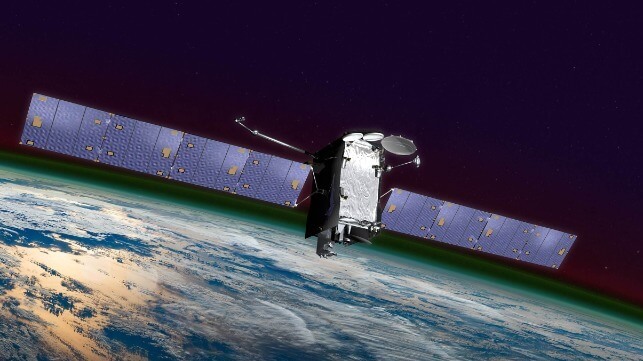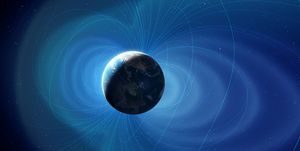Potential operational delineations, or PODs, are helping U.S. land managers

A firefighter works at the site of a controlled burn during the 2022 Fairview Fire in Southern California.
MARIO TAMA/GETTY IMAGES
By Nikk Ogasa
On June 4, 2021, amid flowering saguaros and prickly pear cacti, a wildfire bloomed in the Sonoran Desert in central Arizona. Its nascent flames gorged on nonnative grasses desiccated by a long, severe drought, and the fire was further nourished by the weather. A nearby weather station recorded a temperature of 36° Celsius (97° Fahrenheit). And it was so dry that the blades of firefighters’ bulldozers — used to clear brush — sparked small flames as the heavy vehicles dragged on rocks.
Fire ecologist Mary Lata of the U.S. Forest Service first heard about the fire over the radio while conducting fieldwork off to the north, in the Tonto National Forest. “I remember hearing them talking,” she says, “and little by little realizing they weren’t going to catch this one.”
By June 7, winds had blown the wildfire east-northeast into the Pinal Mountains, in the Tonto’s southern reaches. The flames ascended rapidly, overcoming rock cliffs — defying the expectations of veteran firefighters, Lata says — and sweeping through vast, unbroken stretches of chaparral. When the fire reached the highest elevations, crowned by pine forests, it swallowed those too.
The Telegraph Fire, as it’s now called, grew so intense that it began to create its own wind, its rising heat generating a convective force that sucked in air from the sides, Lata says. “Of all the fires I’ve worked on, Telegraph was the nastiest.”
On the fifth day, the fire neared the city of Globe. By then, it had already consumed an expanse that exceeded the area of Globe five times over. The blaze would go down as one of the largest conflagrations in Arizona history, engulfing some 700 square kilometers of land — equal to about half the area of Phoenix. But the fire would not swallow Globe.
Instead, on a ridge just outside the city, the Telegraph Fire encountered a bulwark, the vestiges of a bygone blaze.
Four years earlier, lightning had sparked the Pinal Fire in this location, albeit under milder conditions. Recognizing the need to clear out vegetation that might feed future blazes, fire crews allowed the blaze to consume litter, seedlings and other brush near to the ground. Crews even ignited flames of their own, expanding the fire’s breadth.
Arriving at the Pinal’s leftovers, the Telegraph Fire “went from a running canopy fire, where it was killing about 60 to 70 percent of the trees that it had encountered, to a creeping ground fire, where it was killing about 1 percent of the trees encountered,” says Kit O’Connor, an ecologist at the Forest Service in Missoula, Mont. Eventually, the fire halted about a kilometer away from a neighborhood in Globe’s outskirts.
Had it not been for the Pinal Fire, the Telegraph Fire would have burned into town, Lata says. “There’s nothing we could have done to stop it.”

The decision to let the Pinal Fire burn had been guided by a new blueprint for wildfire management, known as potential operational delineations. PODs section the landscape into zones within which fires can feasibly be contained. The boundaries are determined before the fire season starts by a mixture of artificial intelligence and local knowledge. A POD network can help land managers identify opportunities to harness wildfires that ignite under manageable conditions. The hope is that if subsequent fires erupt amid extreme conditions, there will be less brush available to fuel their fury.
“If you have a fire that’s rushing towards homes, and there is no burned-out area or fuels cleared around those homes, they’re basically guaranteed to be lost,” says O’Connor, who has helped construct PODs throughout the West.
Today, POD networks sprawl across the West, from California to Washington and as far east as Minnesota. That coverage includes some 70 national forests, as well as state and private lands.
But as these wildfire blueprints spread, they face challenges. Keeping them updated to reflect the changing nature of the landscape is a crucial but difficult endeavor. And whether they will protect the interests of the Indigenous people who have managed the landscape for centuries remains to be seen.
But the need for a new strategy is massive.
Climate change and decades of misguided fire management have steadily stoked wildfires in the West (SN: 6/17/22). Compared with four decades ago, the average area burned by western blazes each year has more than doubled. During the region’s record-breaking 2020 wildfire season, thousands of fires burned an area larger than the state of Maryland. These blazes are now burning more than twice as many homes and buildings as at the beginning of this century — from 2010 to 2020, fires destroyed more than three structures for each 10 square kilometers burned. And scientists predict that more land, and more homes, will burn in the future.
Working with manageable wildfires, or those that emerge in ideal locations under favorable weather conditions, to clear away dense vegetation could help reduce the risk that bigger blazes pose to homes and people across the West. “We can’t make fire go away,” O’Connor says. But “there’s potential for huge benefits” in finding opportunities to use it.
Collaborating to change
On December 4 of last year, there was no smoke discernible in the sky above Monterey, Calif. The worst months of the state’s fire season — July to November — had passed. But as seasons go, so do they return. So on this day in Monterey, a crowd of firefighters, conservationists and researchers had gathered in anticipation of the fires yet to come.
“We’re sort of stuck between two paradigms,” Christopher Dunn told the group. Projected behind him were two images. On the left, a painting from 1905 depicts a member of the Blackfeet Tribe crouched on a prairie, setting fire to the grass with a flaming torch. On the right, a staged photo from 1955 shows a fire brigade of jeeps and a helicopter heading toward a smoking fire in the distance. “We need both of these,” said Dunn, a forestry researcher at Oregon State University in Corvallis.
In 1910, just five years after the birth of the Forest Service, the Big Blowup — some 1,700 wildfires in Montana, Idaho and Washington — burned over 12,000 square kilometers in just a couple days. As a result, Congress passed the 1911 Weeks Act, which effectively outlawed traditional uses of fire by Indigenous people. They had used fire for a trove of benefits, from corralling bison to clearing brushy areas for crops. Then in 1935, the Forest Service enacted the “10 a.m. policy,” in which every reported fire should be suppressed by the 10th hour of the next day.
Fast-forward to today, and about 98 percent of U.S. wildfires are suppressed before reaching 1.2 square kilometers. Suppressing most wildfires has allowed thick, continuous beds of vegetation to grow. Under extreme conditions, such fuel loads can nourish huge blazes like the Telegraph Fire. A landscape with frequent fire, on the other hand, tends to develop a patchwork of areas that burned at different points in the past, with vegetation at various stages of regrowth. Such pyrodiverse landscapes, with their rich mix of habitat types, can boost an area’s biodiversity, scientists suspect. What’s more, recently burned patches contain diminished fuel stocks, which can hinder the growth of wildfires even under extreme conditions, like the Pinal Fire scar did.
“We want more fire,” Dunn said. He was speaking to a crowd focused on developing PODs for lands in and adjacent to California’s Los Padres National Forest, along the state’s mountainous Central Coast between Monterey and Ventura.

First introduced in a 2016 paper based on work led by the Forest Service in California’s Sierra Nevada, PODs are, at their simplest, polygons drawn on a map. Their boundaries typically follow features from where fire can be safely and effectively contained, like ridgetops, roads or rivers. These boundaries can also inform where prescribed burning, selective logging or other actions could be taken to reduce vegetation and minimize fire risk.
POD networks resemble geometric cobwebs, typically strung together during the fire off-season in workshops attended by land managers, tribal members, fire crews, researchers and other local stakeholders. The workshops allow for the proactive sharing of knowledge that might otherwise remain siloed, O’Connor says. “It really helps to involve all the different players in the long-term management of a piece of ground.”
For the second part of the workshop, Dunn and his colleagues spread large topographic maps across tables in two rooms, showing various sections of Los Padres National Forest and proximal lands.
Some of the maps were shaded in where wildfires had burned recently or where measures to reduce flammable vegetation had occurred. Other maps were colored over by a machine learning algorithm that draws from data on topography, fuel characteristics, road networks and historical fires to predict and map the most effective locations for stopping a blaze. This “potential control line” model doesn’t know the land as well as local land managers, but it can help them reach a consensus, O’Connor says.
There were also maps colored by another algorithm, called the suppression difficulty index model. It tells “you how difficult it would be to move people and equipment to any part of the landscape,” O’Connor says. In other words, where it’s hardest to fight a fire from.
Dunn tasked workshop participants with drawing PODs on these maps, using the shaded and colored areas as guides for where to sketch boundary lines. With sharpies in hand, attendants began drawing dark lines on the maps, sometimes following features accentuated by the models, other times diverging. Discussions filled the air.
“The only way to keep going this way is a really gnarly ridge.”
“We used this section on the Dolan Fire. It was good.”
“That road doesn’t go all the way through anymore.”
“It does.”
In some national forests, PODs are augmented with another tool, the Quantitative Wildfire Risk Assessment, or QWRA. These assessments chart where a fire may be most damaging, taking into consideration the locations of homes, endangered species habitats, timber resources and other assets.
When dressed with QWRAs, skeletal POD networks metamorphose into vibrant mosaics, mostly in the colors of a stoplight. When PODs are colored green, they signal areas that could benefit ecologically from fire and where a fire is unlikely to damage resources. Here, letting wildfires burn may be a go. Alternatively, a red POD contains a lot of resources at risk of being lost in a fire. Any emerging fires should probably be stopped. Some PODs fall into an in-between yellow category: The POD could benefit from fire, but only under the right conditions.
With these ratings in hand, land managers can strategize how best to handle fire. The 2017 Pinal Fire emerged in a yellow POD, which firefighters let burn.
After the Monterey workshop, the hand-drawn lines were digitized and made publicly available for viewing on the Risk Management Assistance Dashboard, an online platform developed by the Forest Service in 2020 where users can follow up with comments and suggest alterations.
PODs can also be updated in follow-up workshops in subsequent years. But gathering people year after year is easier said than done. “For [PODs] to be useful, they have to be updated,” says forest and wildlife researcher Michelle Greiner of Colorado State University in Fort Collins. The landscape changes over time. But keeping PODs up-to-date, or even in the awareness of land managers and fire crews, “takes a lot of time and a lot of capacity,” she says, “and I think it kind of remains to be seen if that’s something that’s going to be sustained.”
One step the Forest Service has taken is to hire regional analysts responsible for keeping POD networks updated and relevant, O’Connor says. “We want to make sure that we’re expanding on and growing out of what’s already been done,” he says. “We don’t want these tools to be forgotten.”

Cultural conflicts
Drive about six hours north of Monterey, and you’ll find yourself in the Klamath Mountains, which straddle the California-Oregon border. For thousands of years, Indigenous people from the Karuk, Yurok, Hoopa Valley and other tribes have lived in this rugged region.
Indigenous people’s setting of frequent, low-intensity fires yielded many ecological benefits, such as promoting elk habitat and restoring nutrients to soils. In fact, Karuk and Yurok burning practices, along with naturally ignited fire activity, promoted the stability of a forest in the western Klamath Mountains for a millennium, a 2022 study showed. But suppressive fire policies over the last century have drastically changed the land.
“If you could look back 150 years ago, you would see a landscape that was shaped by fires,” says Nolan Colegrove, a district ranger for the Forest Service and a member of the Hoopa Tribe. In the Klamath Mountains where Colegrove works, lofty Douglas fir trees crowd many patches of land once occupied by grasses or shrubs.
A unique POD network has taken root here. Its development has been led by the North Coast Resource Partnership, or NCRP, an organization helmed by elected officials from the region’s tribes and counties. Across 49,000 square kilometers of northwestern California, the partnership works on projects that benefit local communities and watersheds. Usually, the Forest Service leads the development of PODs, Dunn says. Here, the tribes and counties took up the work. This ensures that everyone in the community is involved, says Will Harling, director of the Mid Klamath Watershed Council, a nonprofit that collaborates on the POD network. Harling notes that when the Forest Service develops a POD network, the agency doesn’t always seek the support or buy-in of everyone in the community. “Everybody that has skin in the game needs to be around that table, or else it doesn’t work,” he says.
Invitees to NCRP’s POD workshops included representatives from local tribes, county governments, the Forest Service, industrial timber, municipal fire departments, homeowners associations, and the California Department of Forestry and Fire Protection. Bringing everyone together was eye-opening, revealing how past efforts to reduce wildfire risk had failed, Harling says.
But the POD approach has sparked disputes. For instance, the data in PODs are publicly available, while much of the ecological and cultural knowledge that tribes possess may be too sensitive for public disclosure. In POD workshops, Indigenous people may help delineate POD boundaries on their historic lands while withholding where along those lines tribal resources exist. Later on, those lines may be treated by fire crews in unexpectedly destructive ways.
“A lot of our [culturally] sensitive areas are on ridges and mountaintops and in these places where [control] lines and other suppression tactics are often constructed,” says Vikki Preston, a member of and cultural resources technician for the Karuk Tribe. When fire crews unaffiliated with tribes come in to clear brush and thin the forest, they can damage or destroy ceremonial trails, archaeological sites and other important tribal resources.
“I’ve seen dozers go through a mushroom patch that people have been picking for generations, and all of a sudden they don’t grow there anymore,” says Bill Tripp, a member of the Karuk Tribe and its director of natural resources and environmental policy.
The Karuk Tribe now tries to assign tribe representatives to accompany any fire crews on POD lines to ensure that culturally important resources are protected.
The strategy was implemented during last summer’s Six Rivers National Forest Lightning Complex Fires. After a flurry of lightning strikes ignited dozens of fires across the Six Rivers National Forest and Redwood National and State Parks in August, a bout of rainfall that dampened the blazes provided land managers with safe conditions to let the fires burn on and to ignite some flames of their own.
Using PODs to identify suitable ridgelines, fire crews accompanied by cultural representatives set flames that crawled downhill to converge with the wildfires. Those strategic ignitions burned areas that the wildfires may have reached eventually, Colegrove says, but they probably burned in a gentler manner. The fire crews took advantage of a natural fire behavior; in the absence of winds, descending blazes generally move less vigorously than those going uphill. So most of the land affected by the set fires burned at low or moderate intensity, Colegrove says. Compared with high-intensity fires, which can move fast and consume entire trees, low- and moderate-intensity fires spread slower and stick closer to the ground, clearing ground-level vegetation.

Such mild fires can be immensely beneficial. In conifer forests like the Six Rivers National Forest, low-intensity blazes reduce the risk of future high-intensity fires by about 64 percent, researchers reported last year in Science Advances, with the effects lasting at least six years.
Though the human-lit flames burned within 100 meters of Harling’s home, he found the risk worthwhile. “After 20 years of community organizing with the Karuk Tribe and partners, the federal agencies finally gave us a chance to use beneficial fire on the landscape,” he says.
Tribal consultations should be integrated into the process of treating lands within a POD, Tripp says. Simply opening the doors for those discussions will spotlight the need to build relationships, he says.
In its 2023 Tribal Action Plan, the Forest Service highlights the importance of assigning a tribal liaison to every wildfire response. Perhaps PODs could be used to illuminate where such liaisons could be most effective, Tripp says. If a POD is developed on land where there is no documented framework for collaborating with a local tribe, he says, that could provide the impetus for bringing on a liaison to build a relationship.
A new language for wildfire
Head to the very center of Arizona, and you will probably end up near Payson. The town is surrounded by the Tonto National Forest and by the world’s largest contiguous stand of ponderosa pine. A few of those scaly-barked, droopy-needled trees are within view of Lata’s office.
“We know that this area burned on average about every seven years,” Lata says, referring to the time before widespread fire suppression began. So long as humans are around, that fire frequency is unlikely to return. “There aren’t going to be a lot of places where we let the natural disturbance cycle play its role, because even though we now understand how important fire is … we don’t have the freedom to put that much fire back in the system,” she says. There’s a limit to how much fire and smoke people will tolerate.

Nonetheless, PODs should help get more fire onto the landscape, and not just through the management of naturally ignited blazes. Managers of the Tonto forest use PODs to identify areas that would benefit from prescribed burning to clear away brush and thus improve wildlife habitat, reduce wildfire risk or reap other ecological benefits.
“It’s kind of a no-brainer to use the PODs as boundaries for those projects,” Lata says.
Others agree. In 2019, the San Juan National Forest of Colorado began integrating PODs into their plans for prescribed burning. That same year, the San Isabel National Forest in Colorado used a POD network to help identify where to clear brush for firebreaks that could help contain future fires. And in 2020, the Washington State Department of Natural Resources also started using PODs to prioritize such treatments and to explain to private landowners why treatments were necessary, and why certain areas were being prioritized for treatment over others.
It helps to have a tool that can show landowners why their neighbors’ property should be treated first, says forest sciences researcher Cole Buettner of Colorado State University. In a 2023 study, he evaluated how PODs have been used in these “non-incident contexts,” as they’re called. “It can help get a lot of support for what you’re doing.”
Perhaps in this regard, PODs serve their most vital function. In translating visions for fire into lines and colors on a map, PODs become a communal language through which a new relationship with wildfire may be forged.
These polygons simplify the conversation, Lata says. “We can just say POD, and we all know what that means.”






